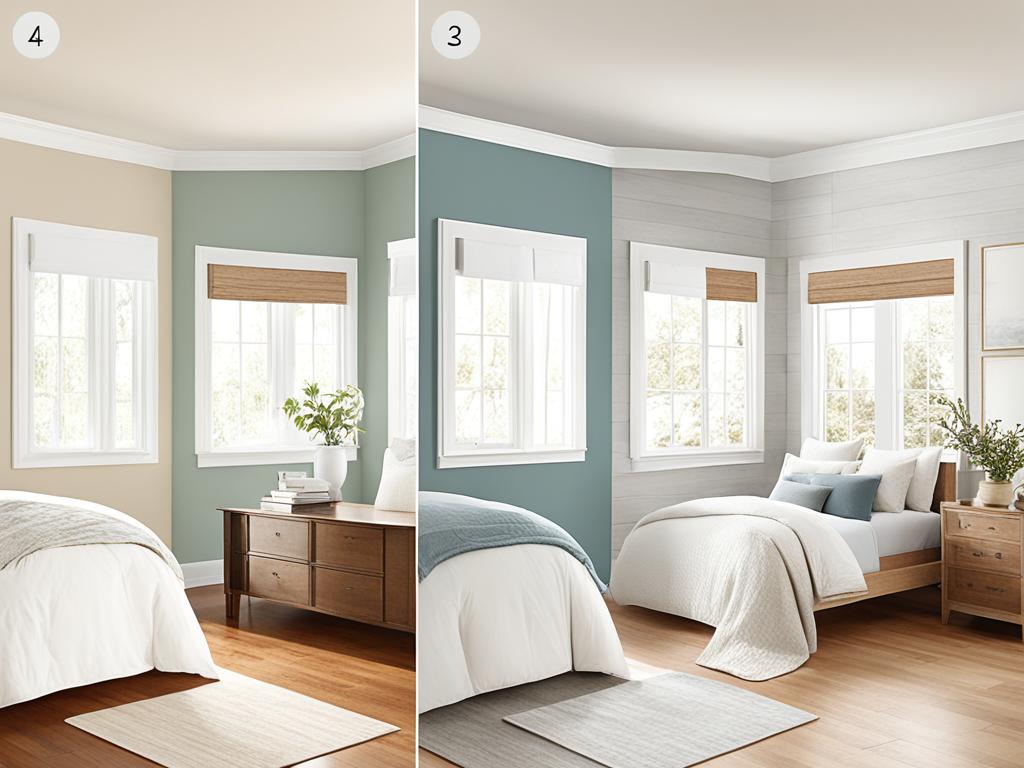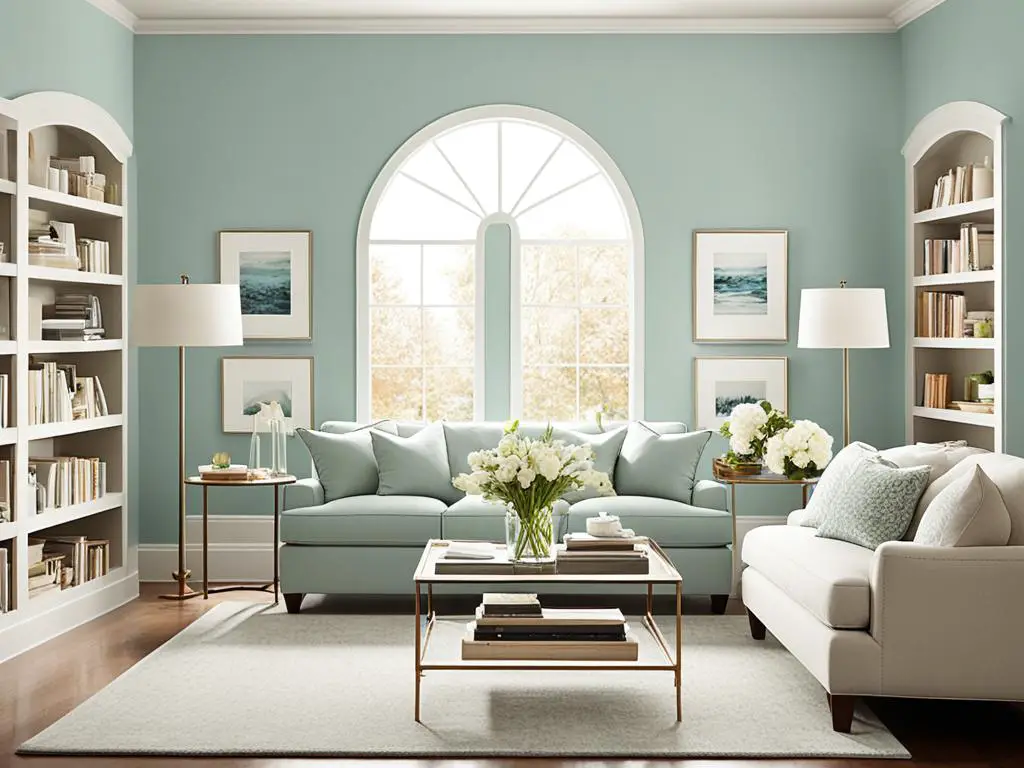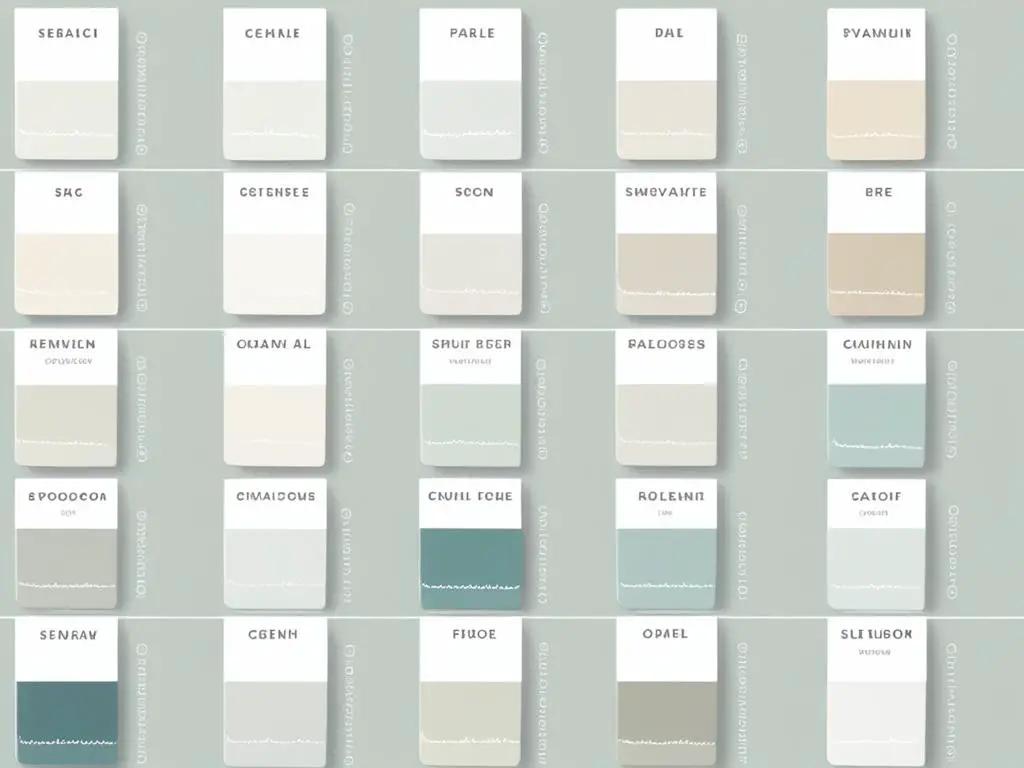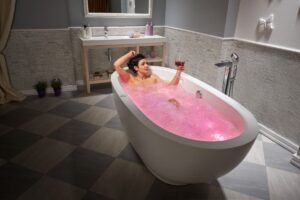When it comes to choosing the perfect paint color for your home, both Benjamin Moore Sea Pearl and Pale Oak are popular choices. These light and versatile shades from Benjamin Moore offer a serene and timeless appeal that can transform any space. In this article, we will compare Sea Pearl and Pale Oak to help you make an informed decision about which shade is right for your home.
Key Takeaways:
- Benjamin Moore Sea Pearl and Pale Oak are both excellent paint colors for creating a serene atmosphere in your home.
- Sea Pearl has a slightly gray appearance and can read as a light greige at times, while Pale Oak has subtle undertones of gray, blue, and purple.
- Consider how different types of lighting can affect the way these colors appear in your space.
- Choose coordinating colors with cool undertones to complement Sea Pearl and Pale Oak.
- Both colors have a light reflectance value that classifies them as light colors, with Pale Oak providing more contrast against white trim.
Undertones and Lighting Effects
Both Benjamin Moore Sea Pearl and Pale Oak have warm undertones, but they have slight differences in their appearances. Sea Pearl has undertones of gray, giving it a light greige hue at times. On the other hand, Pale Oak has subtle undertones of gray, blue, and a hint of purple in certain lighting situations.
It’s important to consider how different types of lighting can affect the way these colors appear in your space. Lighting plays a significant role in how paint colors are perceived, and understanding this can help you make the right choice for your home.
In north-facing light, Sea Pearl may appear more gray, creating a cool and serene atmosphere. Meanwhile, in warm southern lighting, Sea Pearl can read as a light beige, exuding a cozy and inviting vibe.
When it comes to Pale Oak, its appearance can vary throughout the day due to the changing light. In the morning, under east-facing light, Pale Oak may appear more beige and warm, bringing a welcoming ambiance to your space. As the day progresses and the light shifts to a cooler light gray, Pale Oak can transform to create a calming and soothing setting.
West-facing light can also impact the way Sea Pearl is perceived. In the early part of the day, Sea Pearl may appear cool and gray, providing a refreshing feel to your space. However, as the day progresses, it can take on a warmer beige tone, creating a cozy and comfortable atmosphere.
Understanding how lighting affects paint colors is crucial in making the right decision for your space. By considering the different lighting conditions in your home and how they interact with Sea Pearl and Pale Oak, you can create a harmonious and visually pleasing environment.
Lighting Tips
To ensure that you make the best choice between Benjamin Moore Sea Pearl and Pale Oak, consider the following lighting tips:
- Observe how different lighting conditions affect the paint colors throughout the day.
- Take note of the direction your windows face to understand the quality of light in each room.
- Consider using samples and testing the paint colors in different lighting situations before committing to a shade.
- Pay attention to artificial lighting sources, such as lamps and overhead lighting, as they can also influence the appearance of paint colors.
Remember, the ultimate goal is to create a space that reflects your personal style and preferences. Taking into account the undertones and lighting effects of Benjamin Moore Sea Pearl and Pale Oak will help you achieve the perfect atmosphere in your home.
“Light makes photography. Embrace light. Admire it. Love it. But above all, know light. Know it for all you are worth, and you will know the key to photography.” – George Eastman

Coordinating Colors and LRV
When considering the perfect coordinating colors for Benjamin Moore Sea Pearl and Pale Oak, it is crucial to take into account their warm undertones. Both Sea Pearl and Pale Oak have warm undertones, making them compatible with a range of complementary hues. Shades with cool undertones like blues, grays, and gray-greens work particularly well with these two colors, creating a harmonious and balanced palette.
To further understand the nuances and distinctions between Benjamin Moore Sea Pearl and Pale Oak, it is helpful to explore their Light Reflectance Value (LRV). LRV measures the reflectivity of a color, indicating how light or dark it appears. Sea Pearl boasts an LRV of 77.95, making it a light off-white shade that often reads as pure white, especially in well-lit spaces. In low light conditions, Sea Pearl may exhibit more of its greige undertones, adding subtle warmth to your interiors. On the other hand, Pale Oak has a slightly lower LRV of 68.64, falling within the light color category. This lower LRV results in more visible contrast when paired with white trim, making Pale Oak an excellent choice for those seeking a sophisticated yet distinct look.
Aside from the immediate color comparison between Sea Pearl and Pale Oak, it’s also worth exploring other popular colors from Benjamin Moore to have a comprehensive understanding of their unique characteristics. Alabaster, Pale Oak, and White Dove are some notable alternatives that can be compared to Sea Pearl and Pale Oak, providing additional insights into their distinct qualities and helping you make an informed decision for your paint project.
Real Life Examples
To get a better sense of how Benjamin Moore Sea Pearl and Pale Oak look in real homes, we can take a look at photos and descriptions of spaces painted with these colors. Both shades are versatile and can be used in various rooms, including living rooms, bedrooms, bathrooms, kitchens, and more. Real homes using Sea Pearl and Pale Oak showcase their timeless, elegant, and inviting qualities. By seeing these colors in action, you can visualize how they will transform your own space and make an informed decision.
Here are some examples of real homes that have used Benjamin Moore Sea Pearl and Pale Oak:
“We painted our living room in Benjamin Moore Sea Pearl, and it instantly brightened up the space. The color has a subtle gray undertone that adds depth and sophistication. We paired it with crisp white trim and furnishings, creating a classic and elegant look.” – Emily S.
“Our master bedroom is painted in Benjamin Moore Pale Oak, and we couldn’t be happier with the results. The color has a soft and calming effect, perfect for creating a serene atmosphere. It pairs beautifully with our neutral bedding and pops of color in the decor.” – Michael T.
By exploring these real-life examples, you can see how Benjamin Moore Sea Pearl and Pale Oak can transform different spaces in a variety of ways. Whether you’re aiming for a light and airy feel or a cozy and inviting ambiance, these paint colors offer versatility and timeless appeal.
| Room | Color | Description |
|---|---|---|
| Living Room | Benjamin Moore Sea Pearl | Bright and sophisticated with gray undertones |
| Master Bedroom | Benjamin Moore Pale Oak | Soft and calming with a touch of warmth |
| Kitchen | Benjamin Moore Sea Pearl | Light and airy, creating an open and inviting space |
| Bathroom | Benjamin Moore Pale Oak | Subtle and serene, perfect for a spa-like retreat |
As you can see, Benjamin Moore Sea Pearl and Pale Oak are popular choices for real-life homes, offering a range of possibilities when it comes to creating a beautiful and inviting living space.

Conclusion
In conclusion, when it comes to choosing between Benjamin Moore Sea Pearl and Pale Oak, you can’t go wrong with either option. These two paint colors offer a serene and versatile atmosphere for any space in your home.
While Sea Pearl leans slightly towards a gray appearance and can sometimes give off a light greige vibe, Pale Oak features subtle undertones of gray, blue, and purple. Consider the lighting in your room, as it can significantly impact the way these colors appear.
To enhance the overall look, opt for coordinating colors with cool undertones to complement both Sea Pearl and Pale Oak. These two shades have a light reflectance value, classifying them as light colors. However, Pale Oak offers more contrast against white trim.
Ultimately, your choice between Benjamin Moore Sea Pearl and Pale Oak depends on your personal preference and how they fit into your desired color scheme and design aesthetic. Experiment, and select the one that resonates with you the most.
FAQ
What are the differences between Benjamin Moore Sea Pearl and Pale Oak?
Benjamin Moore Sea Pearl has undertones of gray, making it a light greige at times. Pale Oak, on the other hand, has subtle undertones of gray, blue, and a hint of purple in certain lighting situations.
How does lighting affect the appearance of Sea Pearl and Pale Oak?
In different types of lighting, Sea Pearl may appear more gray or beige, while Pale Oak can shift from warm beige to cool light gray throughout the day.
What are the coordinating colors for Sea Pearl and Pale Oak?
Shades with cool undertones, such as blues, grays, and gray-greens, work well with both Sea Pearl and Pale Oak.
What is the Light Reflectance Value (LRV) of Sea Pearl and Pale Oak?
Sea Pearl has an LRV of 77.95, while Pale Oak has an LRV of 68.64. Both colors are considered light, but Pale Oak provides more contrast against white trim.
Can you provide examples of real homes using Sea Pearl and Pale Oak?
Real homes showcase the timeless, elegant, and inviting qualities of Sea Pearl and Pale Oak. These colors can be used in various rooms, including living rooms, bedrooms, bathrooms, kitchens, and more.



